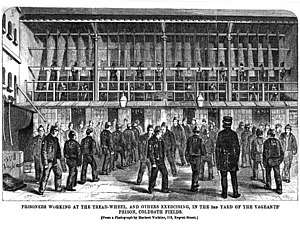Penal treadmill
A penal treadmill was a treadmill with interior steps set into two cast iron wheels. These drove a shaft that could be used to mill corn, pump water or connect to a large fan for resistance.[1]
.jpg)

Penal treadmills were used in prisons in the early Victorian period in Britain as a method of exerting hard labour, a form of punishment prescribed in the prisoner's sentence.[lower-alpha 1]
History
The prison treadwheel was introduced in 1818 by the British engineer Sir William Cubitt (1785–1861) as a means of usefully occupying convicts in the prisons at Bury St Edmunds and Brixton. There had been simple two-man treadmills in prisons before which were used for raising water and grain preparation: these were on a large scale and for a different purpose.[3] Cubitt observed prisoners lying around in idleness, and opined that it was better “reforming offenders by teaching them habits of industry.”[4] It was intended to be pointless and punish; resistance to the motion was provided by straps and weights. Later when prison philosophy had changed it became acceptable to use the energy to power pumps and corn mills.[5] Forty-four prisons in England adopted this form of hard labour to grind grain. Others remained “grinding the wind".[4]
By the Prison Act (1865), every male prisoner over 16 sentenced to hard labour had to spend at least three months of his sentence in labour of the first class. This consisted primarily of the tread-mill, or, as an alternative, the crank machine. This consisted of a small wheel, like the wheel of a paddle steamer, and a handle turned by the prisoner made it revolve in a box partially filled with gravel.[5]
In 1895 there were 39 tread-mills and 29 cranks in use in English prisons, and these had diminished to 13 and 5 respectively in 1901. The use of treadwheels was abolished in Britain in 1902 by the Prison Act 1898.[5][6]
America adopted the treadwheel in 1822, installing one in Bellevue County penitentiary in New York City. A second was erected in 1823, for the cost of $3000 at the Old Newgate Prison in East Granby, CT. A total of only four were built, three of which were quickly abandoned.[7]
Description
The prison treadwheel was a long wooden cylinder with metal framing. It was originally about 6 feet (1.8 m) in diameter. On the exterior of the cylinder were wooden steps about 7.5 inches (19 cm) apart. As the prisoner put his weight on the step it depressed the wheel, and he was forced to step onto the step above, it was an "everlasting staircase". There would be 18 to 25 positions on the wheel, each separated by a wooden partition so each prisoner had no contact with the adjacent prisoner and saw only the wall in front. They walked in silence for six hours a day, taking 15 minutes on the wheel followed by a 5-minute break.[5]
In popular culture
On their 1977 album Storm Force Ten, folk-rock band Steeleye Span included an English folk song called "The Treadmill Song" describing a prisoner's lot at hard labour, including the treadmill.[8] In Charles Dickens' novel "A Christmas Carol," Ebenezer Scrooge references the treadmill, which he describes as "useful."
References
- Notes
- According to The Times in 1827, and reprinted in William Hone's Table-Book in 1838, the distance prisoners walked per day on average varied, from the equivalent of 6,600 vertical feet at Lewes to as much as 17,000 vertical feet in ten hours during the summertime at Warwick gaol.[2]
- Footnotes
- Piette, Elisabeth (2009). "Life in Nineteenth-Century Prisons as a Context for Great Expectations". Victorian Web. Retrieved 19 September 2016.
- "Tread Mills", in The Every-day Book and Table Book; or, Everlasting Calendar of Popular Amusements, Sports, Pastimes, Ceremonies, Manners, Customs, and Events, Each of the Three Hundred and Sixty-Five Days, in Past and Present Times; Forming a Complete History of the Year, Months, and Seasons, and a Perpetual Key to the Almanac, Including Accounts of the Weather, Rules for Health and Conduct, Remarkable and Important Anecdotes, Facts, and Notices, in Chronology, Antiquities, Topography, Biography, Natural History, Art, Science, and General Literature; Derived from the Most Authentic Sources, and Valuable Original Communication, with Poetical Elucidations, for Daily Use and Diversion. Vol III., ed. William Hone, (London: 1838) p 755.
- Evans 2014.
- No Tech 2009.
- Britannica 1926.
- Abbott 2016.
- Early American Crime 2016.
- Mainly Norfolk: English Folk and Other Good Music
- References
- Abbott, Geoffrey (2016). "Treadmill". online: Encyclopædia Britannica. Retrieved 19 September 2016.
- Britannica editors (1926). "Britannica on the treadmill". 13th edition: Encyclopædia Britannica. Retrieved 19 September 2016.CS1 maint: location (link)
- "Prison Treadmills". No tech. Low-tech magazine. Retrieved 19 September 2016.
- Vaver, Anthony. "Prisons and Punishments: The Failure of the Treadmill in America". Early American Crime. Retrieved 19 September 2016.
- Evans, Jill (2014). "On the treadmill: Hard labour at Gloucester Prison". Gloucestershire Crime History. Retrieved 20 September 2016.